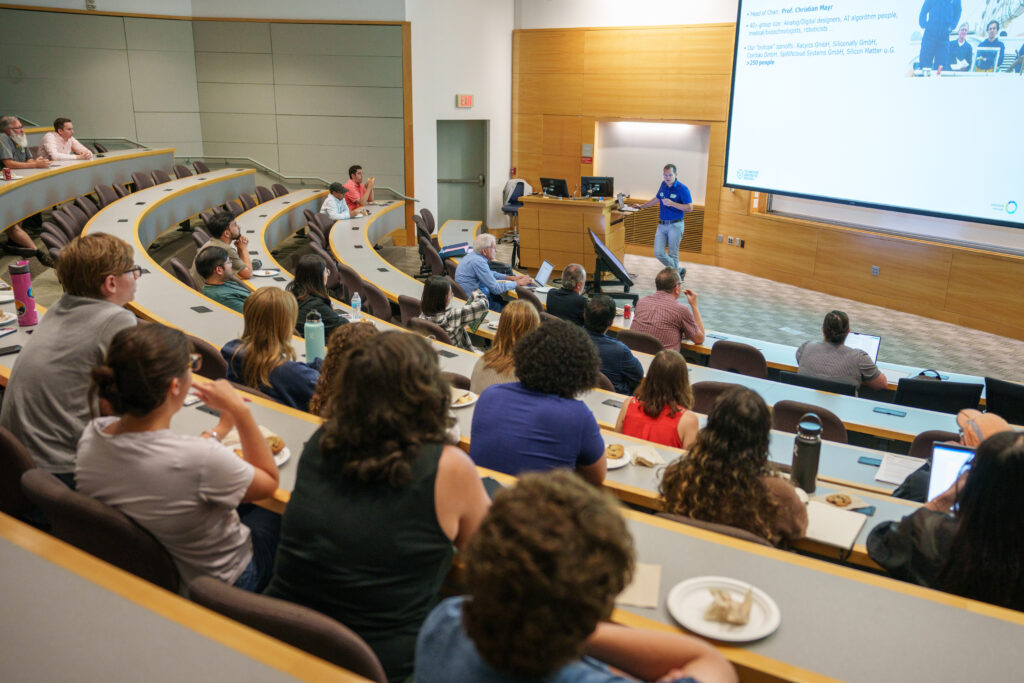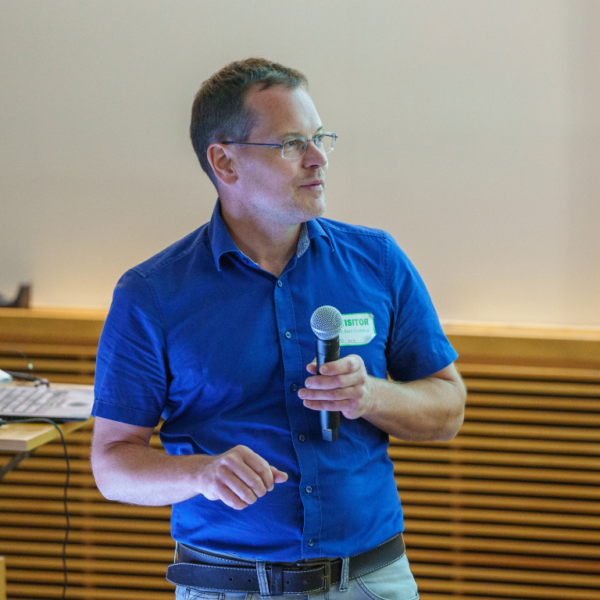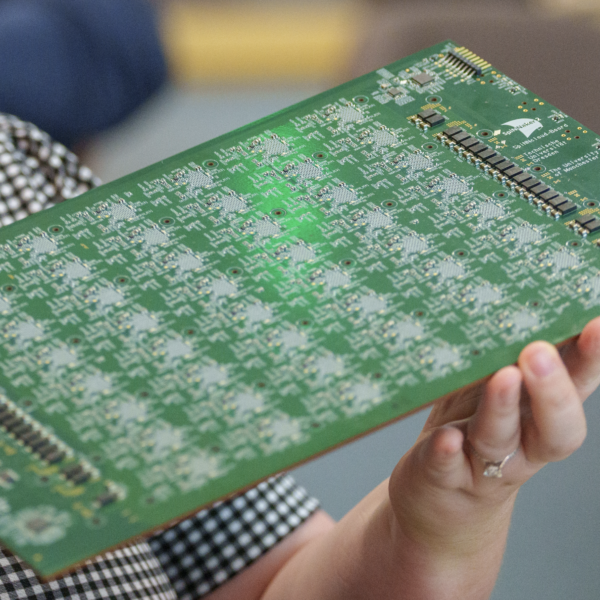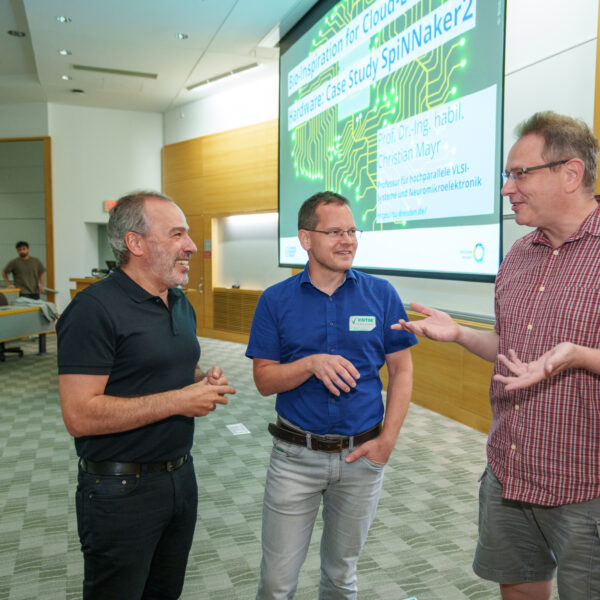 At a July 17 lecture sponsored by the Center for Applied AI in Protein Dynamics, Christian Mayr of Technische Universität Dresden led a discussion on neuromorphic supercomputers, a technology that uses artificial neurons and synapses to process data in a similar way to the human brain. Neuromorphic supercomputing leverages parallel processing to multitask, learn in real time, and make decisions quickly. The technology holds vast potential for drug discovery and image processing, explained Mayr, who developed the technology behind the SpiNNaker2 system, a system that supports the efficient implementation of sparsity-aware artificial neural networks, symbolic AI, and spiking neural networks.
At a July 17 lecture sponsored by the Center for Applied AI in Protein Dynamics, Christian Mayr of Technische Universität Dresden led a discussion on neuromorphic supercomputers, a technology that uses artificial neurons and synapses to process data in a similar way to the human brain. Neuromorphic supercomputing leverages parallel processing to multitask, learn in real time, and make decisions quickly. The technology holds vast potential for drug discovery and image processing, explained Mayr, who developed the technology behind the SpiNNaker2 system, a system that supports the efficient implementation of sparsity-aware artificial neural networks, symbolic AI, and spiking neural networks.
According to Jens Meiler, a collaborator of Mayr’s and a Distinguished Research Professor of Chemistry, Mayr “is an absolute star in this particular community.” Mayr’s contributions to the field have been recognized with numerous awards, including the Siemens Foundation’s English House Prize and the Mastercard Science Prize
To begin his talk, “Bio-Inspiration for Cloud-Level Hardware: Case Study SpiNNaker2,” Mayr reviewed the current technological landscape. He said that currently, even the most sophisticated artificial intelligence hardware is still far away from the 20-Watt –consuming, large scale, and efficient processing offered by the human brain.
“The brain is very much about using its computational communication resources very sparingly,” Mayr said. “Neurons are seriously selective…the brain is very much about focusing information.” This efficiency is key when creating optimal bio-inspired systems like neuromorphic supercomputing.
 Mayr elaborated on the concept of dynamic sparsity, another key feature of the brain’s efficiency that SpiNNaker2 aims to replicate. This approach allows computers to selectively activate only the necessary pathways. Unlike conventional computing, which spreads data across the entire network, the systems that Mayr and his team have created target specific pathways, minimizing energy waste.
Mayr elaborated on the concept of dynamic sparsity, another key feature of the brain’s efficiency that SpiNNaker2 aims to replicate. This approach allows computers to selectively activate only the necessary pathways. Unlike conventional computing, which spreads data across the entire network, the systems that Mayr and his team have created target specific pathways, minimizing energy waste.
SpiNNaker2 “takes inspiration from biology, not just at the single-neuron level like current neuromorphic chips, but throughout all architectural levels,” Mayr said. “It represents the largest cloud system for real-time AI worldwide.”
 “The scale and distributed architecture of SpiNNaker2 enables unique applications of AI in biomedical research,” Hassane Mchaourab, director of the Center for Applied AI in Protein Dynamics, said. “Through the Vanderbilt/Leipzig collaboration, this hardware can be accessible to Vanderbilt researchers.”
“The scale and distributed architecture of SpiNNaker2 enables unique applications of AI in biomedical research,” Hassane Mchaourab, director of the Center for Applied AI in Protein Dynamics, said. “Through the Vanderbilt/Leipzig collaboration, this hardware can be accessible to Vanderbilt researchers.”
Neuromorphic supercomputing systems, including Spinnaker2, are being used to develop applications for smart cities, robotics, large language models, terrestrial and orbital situational awareness systems, and practical applications beyond AI tasks, such as drug discovery.
The lecture concluded with an optimistic outlook on the future of AI. As neuromorphic supercomputing technology gains traction, researchers are poised to unlock new possibilities for its deployment. The systems are already being installed in leading research facilities, where they just beginning to revolutionize high-performance computing.
“Computer hardware development was and will be at the center of the AI revolution,” Mchaourab said. “The seminar was an eye opener of how the next generation of hardware will shape the field.”
About the Center for Applied AI in Protein Dynamics
The Center for Applied AI in Protein Dynamics fosters innovation, implementation, and adoption of artificial intelligence systems and machine learning technologies to advance the frontier of biomolecular dynamics, decipher the mechanisms of diseases, and improve human health. The center’s researchers develop integrated computational and experimental tools to characterize and design the functional dynamics of proteins and leverage this knowledge to advance the discovery of small molecule drug candidates with enhanced precision for distinct conformational states.